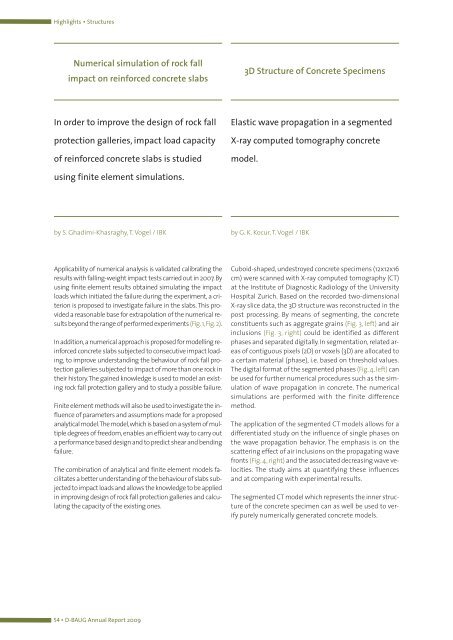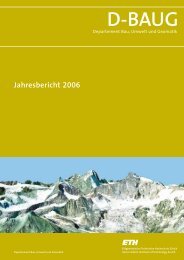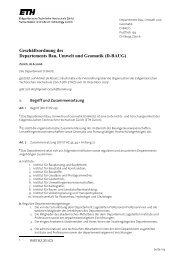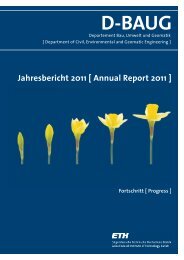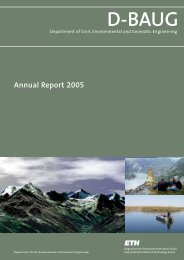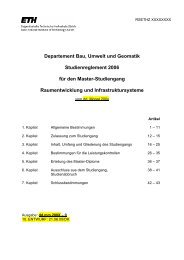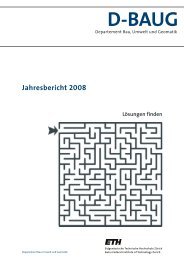D-BAUG - Departement Bau, Umwelt und Geomatik - ETH Zürich
D-BAUG - Departement Bau, Umwelt und Geomatik - ETH Zürich
D-BAUG - Departement Bau, Umwelt und Geomatik - ETH Zürich
Create successful ePaper yourself
Turn your PDF publications into a flip-book with our unique Google optimized e-Paper software.
Highlights ▪ Structures<br />
Numerical simulation of rock fall<br />
impact on reinforced concrete slabs<br />
In order to improve the design of rock fall<br />
protection galleries, impact load capacity<br />
of reinforced concrete slabs is studied<br />
using finite element simulations.<br />
Applicability of numerical analysis is validated calibrating the<br />
results with falling-weight impact tests carried out in 2007.By<br />
using finite element results obtained simulating the impact<br />
loads which initiated the failure during the experiment, a criterion<br />
is proposed to investigate failure in the slabs. This provided<br />
a reasonable base for extrapolation of the numerical results<br />
beyond the range of performed experiments (Fig.1,Fig.2).<br />
In addition,a numerical approach is proposed for modelling reinforced<br />
concrete slabs subjected to consecutive impact loading,<br />
to improve <strong>und</strong>erstanding the behaviour of rock fall protection<br />
galleries subjected to impact of more than one rock in<br />
their history.The gained knowledge is used to model an existing<br />
rock fall protection gallery and to study a possible failure.<br />
Finite element methods will also be used to investigate the influence<br />
of parameters and assumptions made for a proposed<br />
analytical model.The model,which is based on a system of multiple<br />
degrees of freedom,enables an efficient way to carry out<br />
a performance based design and to predict shear and bending<br />
failure.<br />
The combination of analytical and finite element models facilitates<br />
a better <strong>und</strong>erstanding of the behaviour of slabs subjected<br />
to impact loads and allows the knowledge to be applied<br />
in improving design of rock fall protection galleries and calculating<br />
the capacity of the existing ones.<br />
54 ▪ D-<strong>BAUG</strong> Annual Report 2009<br />
Elastic wave propagation in a segmented<br />
X-ray computed tomography concrete<br />
model.<br />
by S. Ghadimi-Khasraghy, T. Vogel / IBK by G. K. Kocur, T. Vogel / IBK<br />
3D Structure of Concrete Specimens<br />
Cuboid-shaped, <strong>und</strong>estroyed concrete specimens (12x12x16<br />
cm) were scanned with X-ray computed tomography (CT)<br />
at the Institute of Diagnostic Radiology of the University<br />
Hospital Zurich. Based on the recorded two-dimensional<br />
X-ray slice data, the 3D structure was reconstructed in the<br />
post processing. By means of segmenting, the concrete<br />
constituents such as aggregate grains (Fig. 3, left) and air<br />
inclusions (Fig. 3, right) could be identified as different<br />
phases and separated digitally. In segmentation, related areas<br />
of contiguous pixels (2D) or voxels (3D) are allocated to<br />
a certain material (phase), i.e. based on threshold values.<br />
The digital format of the segmented phases (Fig. 4, left) can<br />
be used for further numerical procedures such as the simulation<br />
of wave propagation in concrete. The numerical<br />
simulations are performed with the finite difference<br />
method.<br />
The application of the segmented CT models allows for a<br />
differentiated study on the influence of single phases on<br />
the wave propagation behavior. The emphasis is on the<br />
scattering effect of air inclusions on the propagating wave<br />
fronts (Fig. 4, right) and the associated decreasing wave velocities.<br />
The study aims at quantifying these influences<br />
and at comparing with experimental results.<br />
The segmented CT model which represents the inner structure<br />
of the concrete specimen can as well be used to verify<br />
purely numerically generated concrete models.


